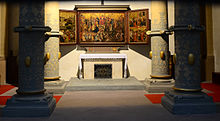Gert van Lon

Gert van Lon (also van Loon ; * around 1465 in Geseke / Westphalia ; † 1521 or later) was a German painter.
Gert van Lon is seen as a little talented painter who probably learned his craft from the master of Liesborn . Little is known about his life. In 1505 he signed a contract with the nuns of the Benedictine monastery in Willebadessen for the delivery of a high altar , which was only delivered in 1521. One wing of this altar is now in the LWL State Museum for Art and Cultural History in Münster . In the years 1511 and 1515 he is documented as the caretaker of the town church of Lemgo . In 1512 he accepted the commission of several citizens of Lemgo to paint an altar panel for St. Joest . With the delivery of the altar for the Benedictine convent Willebadessen in 1521, he received the order for a new altar. It is unclear whether he also carried out this, since no data from Van Lons have been preserved after this time.
In the late work attributed to him, a massive drop in the quality of his already mediocre performance can be ascertained, which suggests that he had the work carried out by insufficiently trained students. It cannot be ruled out that the workshop was continued under his name by a successor who was stylistically based on him.
Despite the provinciality of his work, the works of van Lon seem to have been in demand, as the relatively large number of preserved works ascribed to him shows.
Works

-
Verne, Catholic Church, St. Bartholomew
- three frescoes, passion cycle, restored in 2013
-
Frankfurt a. M., Dom
- Mannalese. (Wing of an altar)
- The Transfiguration of Christ. (Wing of an altar)
-
Listen, parish church
- Crucifixion of Christ.
-
Cologne, Museum of Applied Arts
- Christ on the cross.
-
Lippstadt, Nikolaikirche
- Crucifixion altar.
-
Minden, cathedral parish office
- Crucifixion of Christ.
-
Münster, Westphalian State Museum for Art and Cultural History
- Wing of the altar from the Benedictine monastery of Willebadessen: inside - Resurrection of Christ, Ascension of Christ, outpouring of the Holy Spirit, Last Judgment; Outside - Saints Vitus, Benedict, Cosmas and Damian
- Allegory of Redemption.
- Saints Peter and Paul. (Fragment of an altar wing)
- Crucifixion altar.
- Kinship altar.
-
Paderborn, Busdorf Church
- Crucifixion altar. ( The middle panel with depictions of the "Carrying the Cross", "Crucifixion", "Entombment" and "Christ in Limbo" as well as a wing with remains of a "Gregory Mass" have been preserved)
-
Paderborn, Diocesan Museum
- Church flag from Fröndenberg: Front - Annunciation; Reverse - Coronation of Mary.
- Church flag from Fröndenberg: front side - birth of Christ; Reverse - Adoration of the Magi.
-
Paderborn, cathedral
- World Judgment Altar.
-
Wewelsburg, rectory
- Scenes from the Meinulphius legend. ( There are two fragments that show the "saint before Charlemagne" and an "interrogation before the bishop" )
-
Whereabouts unknown
- Calvary. (auctioned on February 27, 1918 at Lempertz in Cologne )
literature
- Alfred Stange : Critical index of the German panel paintings before Dürer ; Vol. 1: Cologne, Lower Rhine, Westphalia, Hamburg, Lübeck and Lower Saxony . Munich: Bruckmann, 1967, pp. 170–172.
- Michael Wessing: Gert van Lon. A contribution to the history of late Gothic painting in Westphalia. Frankfurt am Main [u. a.]: Lang, 1986. ISBN 978-3-8204-9655-0
Individual evidence
- ^ Alfred Stange (1967), p. 170 f.
- ↑ See Didier Méhu, The Middle Ages. Of princes and merchants, monks and serfs, crusaders and minstrels. Freiburg 2008. pp. 102f.
| personal data | |
|---|---|
| SURNAME | Lon, Gert van |
| ALTERNATIVE NAMES | Loon, Gert van |
| BRIEF DESCRIPTION | German painter |
| DATE OF BIRTH | around 1465 |
| PLACE OF BIRTH | Geseke |
| DATE OF DEATH | after 1521 |